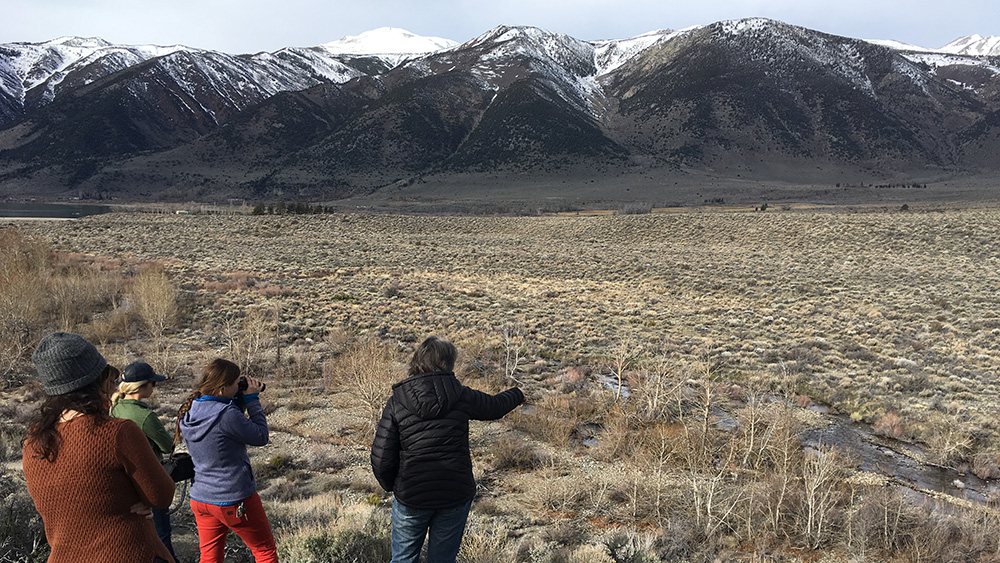
This post was written by Lisa Cutting, 2002-2020 Eastern Sierra Policy Director, 2000-2001 Environmental Resource Coordinator, and 1999 Mono Lake Intern.
Almost a year after the epic 2017 winter and resulting record Mono Basin runoff, positive effects from the high flows can still be seen on all of Mono Lake’s tributary streams—including, notably, the beleaguered floodplain of the Mill Creek bottomlands.

Last summer, long-dry side channels in the bottomlands carried water when Lundy Lake Reservoir spilled for almost the entire summer. Some of these rewatered channels are still flowing despite low-flow early springtime conditions, and evidence of lasting restoration benefits is abundant. Back eddies and ponded areas well away from flowing channels continue to hold water. Below the surface, recharged groundwater is once again available for vegetation, and fine sediment deposited across floodplain cobble is primed for new seedlings to grow. All of this is a glimpse into Mill Creek’s bright future.
Restoration vision
As Mono Lake’s third-largest tributary, Mill Creek should carry a significant amount of water, but hasn’t for over a century. Most Mill Creek water is diverted for hydropower generation and, due to infrastructure limitations, is not returned to the creek as it should be. The resulting lack of water has caused vegetation, including stands of large cottonwoods, to die, and has degraded habitat essential for migratory songbirds, trout, and other wildlife. Overall, Mill Creek gets the short end of the stick and is barely hanging on.
The Mono Lake Committee is working to change this situation and has long held that Mill Creek has the greatest restoration potential of any stream in the Mono Basin. Because most of the stream was never completely dewatered, the damaged area is primarily the stream’s lower section closest to Mono Lake. The Committee’s goal is to increase Mill Creek flows by managing water upstream in a manner consistent with long-established water rights. The next step is to mimic the seasonal pattern of the natural hydrograph in order to activate natural stream restoration processes. As we have seen with other Mono Lake tributaries, providing water and flows following the natural hydrograph goes a long way to restoring the form and function necessary for healthy habitat.
Removing invasive plants in the meantime
Streams that do not receive natural flows are vulnerable to non-native plant invasion because invasive plants establish quickly and out-compete native plants for water and space. The Committee has seen this happen on both Lee Vining and Rush creeks, and has been proactively removing invasive plants in the lower reaches of Mill Creek for over a decade, educating and engaging volunteers and school groups in the process.
The most predominant invasive species on Mill Creek is white sweet clover (Melilotus albus). Sweet clover is especially problematic because the mature plants are tall (3–5 feet), and its hard and light seeds are easily dispersed and can stay viable in the soil for up to 30 years. Advance removal of sweet clover helps give the native streamside vegetation the best chance to establish once restoration flows begin.
Side channels fundamental to vegetation health
Near Mono Lake, Rush, Lee Vining, and Mill creeks all have “inner delta” bottomlands consisting of multiple stream channels, which provide a unique mix of riparian forests, wooded wetlands, and backwater marshes. This is rare in the region—Eastern Sierra streams are usually ribbon-like with a narrow band of vegetation closely following the creek. The Mono Basin’s lush cottonwood-willow riparian bottomland habitats are oases for birds, fish, and wildlife in an otherwise dry sagebrush scrub environment.
Rewatering dry side channels in Mill Creek’s lower reaches is also key to restoring these important bottomlands. To function properly, multiple side channels are necessary to distribute surface water and recharge groundwater so vegetation can survive in periods of little water. This groundwater “sponge” effect was evident in our flow monitoring during recent years. Together with newly-deposited fine sediment, it means native plants will get a boost this summer.
Because it is so unusual that these flow conditions have persisted through the winter, we will be mapping the length of the rewatered channels and the acreage of vegetation benefiting from the groundwater recharge. The Committee continues to work to secure the return of flows to Mill Creek consistent with water rights—in the meantime, we continue to do everything we can to ensure that Mill Creek’s eventual restoration will result in a beautiful and healthy stream once again.
This post was also published as an article in the Summer 2018 Mono Lake Newsletter (pages 6 and 22).
